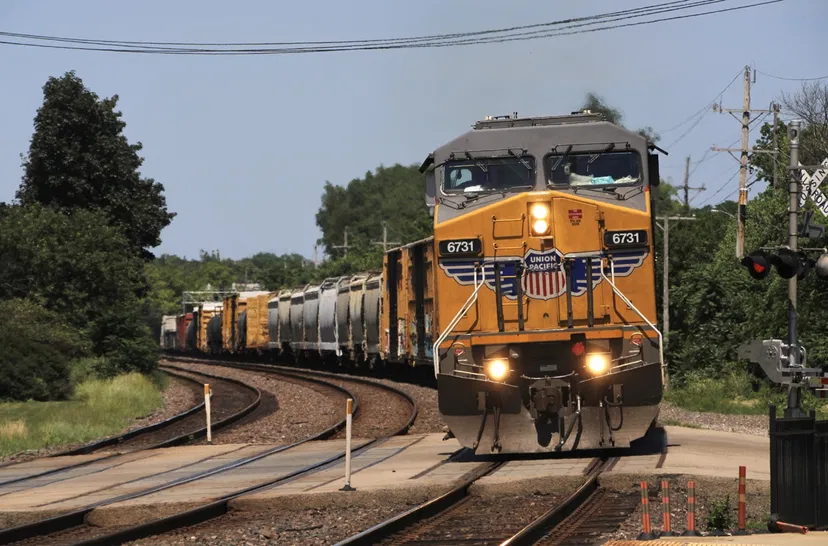Veranderend landschap van spoorwegvoorschriften
De potentiële fusie van Union Pacific en een andere Class I-spoorwegmaatschappij heeft de interesse gewekt in de hele transportsector, waarbij de complexe wisselwerking tussen bedrijfsstrategie, investeringsinzichten en regelgevingskaders wordt benadrukt. Dit onderzoek gaat dieper in op de vraag hoe deze ontwikkeling de logistiek en het bredere landschap van goederenvervoer kan beïnvloeden.
Belangrijkste inzichten
- Union Pacific overweegt actief een concurrerende Class I-spoorwegmaatschappij over te nemen met begeleiding van Morgan Stanley.
- Het streven van het bedrijf naar een fusie staat voor aanzienlijke wettelijke toetsingen die zijn vastgesteld door de Surface Transportation Board, waardoor elke fusie de concurrentie moet bevorderen en het openbaar belang moet dienen.
- Met de huidige politieke samenstelling van de raad van bestuur, zal elke voorgestelde fusie naar verwachting vertragingen oplopen, mogelijk tot 2026 voor nieuwe benoemingen.
- Na de aankondiging over mogelijke overnameplannen reageerden beleggers—wat resulteerde in een stijging van de aandelen van concurrenten CSX en Norfolk Southern, terwijl het aandeel van Union Pacific een dalende trend vertoonde.
Markt Reacties en Perspectieven van Belanghebbenden
De samenwerking van Union Pacific met investeringsbankiers van Morgan Stanley benadrukt hun intentie om de complexiteit van een mogelijke fusie te doorgronden. Ondanks het uitblijven van publieke commentaren van zowel Union Pacific als Morgan Stanley, is de interesse van investeerders duidelijk. De huidige omgeving suggereert dat institutionele spelers mogelijke verschuivingen in het spoorweglandschap afwegen, wat door logistieke netwerken in het hele land kan weerklinken.
Jim Vena, de Chief Executive van Union Pacific, heeft de toekomstige voordelen van een transcontinentale fusie benadrukt. Hij heeft echter ook openhartig de wettelijke hindernissen erkend die een prominente factor blijven in het planningsproces.
Een nadere blik op regelgevingskaders
De Surface Transportation Board (STB) heeft in 2001 de protocollen voor de beoordeling van fusies geactualiseerd, als reactie op een golf van consolidaties in de jaren negentig, waaronder spraakmakende fusies zoals de Burlington Northern-Santa Fe en de Union Pacific-Southern Pacific deals. De nieuw ingevoerde regelgeving vereist dat fusies de concurrentie substantieel verbeteren en voordelen voor het publiek opleveren. Deze verwachtingen benadrukken het belang van publiek belang bij de overweging van fusies, waardoor alle markten die afhankelijk zijn van deze transportnetwerken worden beïnvloed.
Hoewel het huidige politieke evenwicht van de STB, met twee Republikeinen en twee Democraten, het fusielandschap bemoeilijkt, suggereren de bruikbare inzichten van analisten dat strategische fusiebesprekingen uiteindelijk afhankelijk kunnen zijn van de bevestiging van een derde Republikeins lid, niet eerder dan 2026 verwacht.
Implicaties van fusies op logistiek en goederenverkeer
Het begrijpen van de dynamiek en implicaties van grootschalige fusies wordt met name in de logistiek van essentieel belang. Een succesvolle fusie kan leiden tot meer gestroomlijnde activiteiten, verbeterde efficiëntie in het goederenvervoer en betere dienstverlening in het algemeen. Wanneer twee Class I-spoorwegmaatschappijen hun krachten bundelen, kan dit een aanzienlijke impact hebben op lading distributielogistiek, wat leidt tot veranderingen in verzending stromen en transportstrategieën.
| Mogelijkheid | Impact op logistiek |
|---|---|
| Verhoogde capaciteit | Verbeterd vermogen om grotere vrachtvolumes te verwerken. |
| Uitgebreide servicegebieden | Nieuwe routes zouden geopend kunnen worden, waardoor de distributiemogelijkheden toenemen. |
| Kostenbesparingen | Potentiële efficiëntie kan leiden tot lagere operationele kosten. |
| Verhoogd marktaandeel | Grotere onderhandelingsmacht met leveranciers en vervoerders. |
Strategische richting vooruit
Hoewel de toekomst van een fusie van Union Pacific onzeker blijft, mogen de potentiële effecten ervan op de vrachtlogistiek niet worden onderschat. Het concurrentielandschap zal waarschijnlijk een transformatieve periode ingaan, waarbij verschillende spelers in de sector om de positie strijden. Het in de gaten houden van deze ontwikkelingen is essentieel voor iedereen die betrokken is bij vrachtlogistiek en transport.
Zelfs nu er complexiteiten in overvloed zijn, bedrijven zoals GetTransport.com blijven van onschatbare waarde voor logistieke en transportbehoeften door wereldwijd betaalbare oplossingen voor goederenvervoer te bieden. Het platform zorgt ervoor dat mensen niet in de steek worden gelaten door opties te bieden voor kantoorverhuizingen, huisverhuizingen en aanzienlijke goederen zoals meubels en voertuigen. In een steeds evoluerend transportlandschap, GetTransport.com vereenvoudigt de logistiek voor uiteenlopende behoeften.
Conclusie
Het vooruitzicht van een fusie tussen Union Pacific en een andere Class I-spoorweg illustreert de ingewikkelde dans van strategie en regulering binnen de spoorwegindustrie. Terwijl bedrijven door deze mogelijke veranderingen navigeren, moet ook het logistieke landschap evolueren om nieuwe routes en operationele efficiëntie te faciliteren. In deze onvoorspelbare omgeving is het van vitaal belang om te vertrouwen op middelen die klaarstaan om een naadloos transport te faciliteren. Op GetTransport.com, kunnen gebruikers betaalbare en betrouwbare transportoplossingen verkennen die inspelen op hun unieke logistieke behoeften. De kracht van weloverwogen besluitvorming leidt klanten naar slimmere logistieke oplossingen. Boek uw rit op GetTransport.com.

 Union Pacific's potentiële spoorwegfusie ontvouwt zich temidden van regelgevende uitdagingen">
Union Pacific's potentiële spoorwegfusie ontvouwt zich temidden van regelgevende uitdagingen">